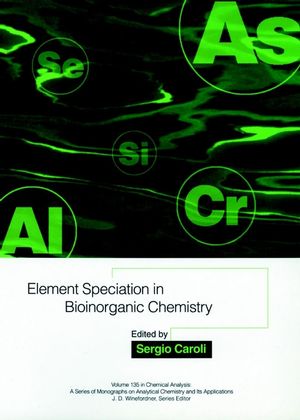Element Speciation in Bioinorganic ChemistryISBN: 978-0-471-57641-9
Hardcover
474 pages
April 1996
 This is a Print-on-Demand title. It will be printed specifically to fill your order. Please allow an additional 15-20 days delivery time. The book is not returnable.
|
||||||
Element speciation determines the different forms a chemicalelement can take within a given compound, enabling chemists topredict possible ramifications for the environment and humanhealth. This comprehensive book focuses on the analytical aspectsand instrumentation of speciation, while covering the gamut ofmetal speciation forms with adverse effects on biological materialsand the environment at large.
The book consists of contributions by a truly international groupof leading authorities on element speciation in bioinorganicchemistry. The editor--a contributor here himself--traces thedevelopments in the field, discussing the advances made over thepast decade in various methodologies and the significance of theincreased capacity to detect extremely small concentrations oftrace elements in various media.
Several chapters are dedicated to the various methods andapplications of speciation, exploring specific analytical methods,such as direct, chromatographic and nonchromatographic methods, aswell as nuclear-based and voltammetric methods. Others coverspeciation in various natural water and marine environments and itsmanifestation in biological materials, human serum, or foodstuff.In addition, the book examines speciation theory and legal aspectsas well as questions of quality and sources of errors--issues thatunderscore the perennial need to develop new methods for obtainingstill more accurate data.
Extremely broad in scope and rich in detail, this volume providesthe key to improving the state of the art in the field, and is sureto stimulate further research. It stands as a one-of-a-kindreference for analytical and inorganic chemists, as well asbiochemists, in a wide range of disciplines, including toxicology,environmental science, nutrition research, clinical chemistry, andpharmacology.
A complete reference for the analytical and instrumental aspects ofspeciation
This unique volume provides both a comprehensive reference and apractical guide to the complete range of issues arising fromelement speciation. It concentrates on analytical methods andinstrumentation in bioinorganic chemistry--especially as applied towater-related projects--while addressing the larger environmentaland human-health concerns of our times.
Complete with over 100 illustrations, this collaborative effort byan international group of experts describes
* Methods for the detection and analysis of species elements,including direct methods, atomic spectrometry, nuclear activationanalysis and radio tracer, high-performance chromatography, orvoltammetric procedures
* Specific effects of various species elements, including heavymetals, arsenic, and many other trace elements
* Biological materials showing concentrations of trace elements,including human serum, milk, and marine organisms
* Various environments affected by element speciation, such asnatural waters, sea waters, estuarine, and coastal environments
* How to avoid common pitfalls and obtain sound and accuratedata
For anyone involved in environmental and earth sciences, as well asthe related areas of public health, pharmacology, toxicology,nutritional research, or environmental regulations, this importantwork offers the most systematic survey of element speciation todate. It also provides historical perspective, a preview ofexpected developments, and a multitude of new ideas for furtherresearch.
The author of approximately 240 published papers and three previousbooks, Dr. Caroli is an active member of numerous national andinternational committees and organizations concerned with chemicalsin the environment. He also sits on the editorial or advisoryboards of several scientific journals, including the Journal ofAnalytical Atomic Spectroscopy, Environmental Science and PollutionResearch International, and Microchemical Journal.
The book consists of contributions by a truly international groupof leading authorities on element speciation in bioinorganicchemistry. The editor--a contributor here himself--traces thedevelopments in the field, discussing the advances made over thepast decade in various methodologies and the significance of theincreased capacity to detect extremely small concentrations oftrace elements in various media.
Several chapters are dedicated to the various methods andapplications of speciation, exploring specific analytical methods,such as direct, chromatographic and nonchromatographic methods, aswell as nuclear-based and voltammetric methods. Others coverspeciation in various natural water and marine environments and itsmanifestation in biological materials, human serum, or foodstuff.In addition, the book examines speciation theory and legal aspectsas well as questions of quality and sources of errors--issues thatunderscore the perennial need to develop new methods for obtainingstill more accurate data.
Extremely broad in scope and rich in detail, this volume providesthe key to improving the state of the art in the field, and is sureto stimulate further research. It stands as a one-of-a-kindreference for analytical and inorganic chemists, as well asbiochemists, in a wide range of disciplines, including toxicology,environmental science, nutrition research, clinical chemistry, andpharmacology.
A complete reference for the analytical and instrumental aspects ofspeciation
This unique volume provides both a comprehensive reference and apractical guide to the complete range of issues arising fromelement speciation. It concentrates on analytical methods andinstrumentation in bioinorganic chemistry--especially as applied towater-related projects--while addressing the larger environmentaland human-health concerns of our times.
Complete with over 100 illustrations, this collaborative effort byan international group of experts describes
* Methods for the detection and analysis of species elements,including direct methods, atomic spectrometry, nuclear activationanalysis and radio tracer, high-performance chromatography, orvoltammetric procedures
* Specific effects of various species elements, including heavymetals, arsenic, and many other trace elements
* Biological materials showing concentrations of trace elements,including human serum, milk, and marine organisms
* Various environments affected by element speciation, such asnatural waters, sea waters, estuarine, and coastal environments
* How to avoid common pitfalls and obtain sound and accuratedata
For anyone involved in environmental and earth sciences, as well asthe related areas of public health, pharmacology, toxicology,nutritional research, or environmental regulations, this importantwork offers the most systematic survey of element speciation todate. It also provides historical perspective, a preview ofexpected developments, and a multitude of new ideas for furtherresearch.
The author of approximately 240 published papers and three previousbooks, Dr. Caroli is an active member of numerous national andinternational committees and organizations concerned with chemicalsin the environment. He also sits on the editorial or advisoryboards of several scientific journals, including the Journal ofAnalytical Atomic Spectroscopy, Environmental Science and PollutionResearch International, and Microchemical Journal.



